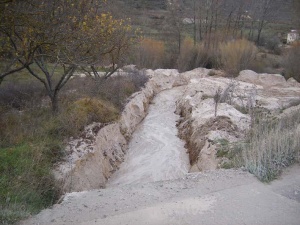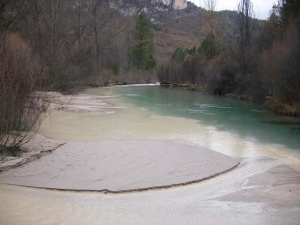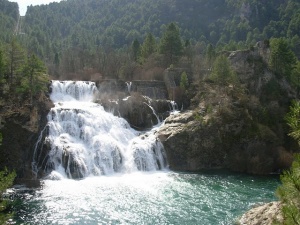Difference between revisions of "Tajo. Improvement of ecological state of the Tajo and tributaries riverside affected by the spill of kaolin, at Poveda de la Sierra and Taravilla (Guadalajara)"
m (→Measures selection) |
m (→Extra background information) |
||
| Line 62: | Line 62: | ||
The REMEDINAL research group, formed of geomorphologists and ecologists from the Universidad Complutense de Madrid and the Universidad de Alcalá de Henares<ref>http://www.remedinal.org/plt_Home.aspx</ref> <ref>http://www.remedinal.org/plt_Page.aspx?IdObjeto=755</ref>has the following objectives: | The REMEDINAL research group, formed of geomorphologists and ecologists from the Universidad Complutense de Madrid and the Universidad de Alcalá de Henares<ref>http://www.remedinal.org/plt_Home.aspx</ref> <ref>http://www.remedinal.org/plt_Page.aspx?IdObjeto=755</ref>has the following objectives: | ||
:*Identify and quantify the sediment sources to the Tajo river network (including the 'natural', as the gullies) using direct methods (monitoring and quantification the filling of gabion weirs on the environment) and indirect (through the use of different empirical formulas, such as the RUSLE 1.06 or MUSLE). | :*Identify and quantify the sediment sources to the Tajo river network (including the 'natural', as the gullies) using direct methods (monitoring and quantification the filling of gabion weirs on the environment) and indirect (through the use of different empirical formulas, such as the RUSLE 1.06 or MUSLE). | ||
| − | :*Study the historical evolution of hydrology and sediment contribution in the vicinity of Poveda de la Sierra and Peñalén; and provide information and useful criteria for the correction of the environmental impact of mines, mainly through its eco-hydrological restoration. | + | :*Study the historical evolution of hydrology and sediment contribution in the vicinity of Poveda de la Sierra and Peñalén; and provide information and useful criteria for the correction of the environmental impact of mines, mainly through its eco-hydrological restoration.<br /> |
| + | Since 2008, the NGO AEMS, Ríos con Vida is developing a volunteer project funded by the River Volunteer and Environmental Education Program of the Ministry of Environment.The actions carried out involve raking and cleaning of river beds, monitoring and educational sampling of aquatic bioindicators. The results have been satisfactory until now<ref>http://www.riosconvida.es/riosconvida.htm</ref>. | ||
==References== | ==References== | ||
Revision as of 16:14, 21 April 2010
Tajo. Improvement of ecological state of the Tajo and tributaries riverside affected by the spill of kaolin, at Poveda de la Sierra and Taravilla (Guadalajara)
Key features of the case study
- This project is part of the National strategy for River Restoration, an initiative of the Ministry of Environment, and implemented at the Tajo basin by the Confederación Hidrográfica del Tajo.
- The zone of actuation is included in the CSI ES4240016, ZEPA ES0000092, Parque Natural del Alto Tajo y zona periférica de protección de la Microrreserva Prados Húmedos de Torremocha del Pinar.
- The open air mining releases a great quantity of sediments which are incorporated into the Tajo river and its tributaries at the area between Peñalén, Poveda de la Sierra and Taravilla.Despite the construction of pools for collect the runoff and the sediment scours from the mining exploitations, some turbidity can be observed, and so deposition of fine sediments at the pools( The thickness of the sediment layer reaches 20 cm at the confluence of the Merdero stream with the Tajo). The result is the alteration of the water quality and tha availability of instream habitat.
- The presence of a levee known as Salto de la Poveda makes impossible the movement upstream of the fishes, though its elimination wouldn´t be enough to enable the migration. The structure is cimented over a natural step at the longitudinal profile.
- This project is part of the National strategy for River Restoration, an initiative of the Ministry of Environment, and implemented at the Tajo basin by the Confederación Hidrográfica del Tajo.
Site description
The Alto Tajo is characterised by a network of canyons, gorges, terraces, and singular landscape shapes. This is the largest gorges system of the region, with great diversity (geologic, climatic and topograhic)and in an excellent state of preservation. this variety of environments provides a high diversity oh habitats for wildlife. Among birds of prey include: vultures, kestrels and hawks, followed by hawks, eagles and peregrine falcons.among the mammals we find: wild cats, spears, otters, polecats and weasels. Of the small mammals are the most abundant rodents: voles, house mice, dormice, squirrels, followed by insectivores.
Also remarkable is the presence of 15 species of reptiles, among them the common gecko, lizards, snakes, "lagarto ocelado" and snub-nosed viper, nine kinds of amphibians and seven native species of fish.
the vegetation of the watershed is characterised by extensive pine stands, composed of different pine species (Pynus sylvestris, Pinus nigra and Pinus Pinaster. The woods of pines are found mainly at the hillside valleys and higher elevations. Under the cover of the pine trees are oaks, holm oak and downy oak. In the center of the Alto Tajo Natural Park, at the limestone moors, are juniper forests.
The riparian forest consists of black and trembling aspen, willow, elm, linden, hazel, privet and birch among other species.
In the park there are many species that found in salt marshes, bogs, ponds and lagoons, rocky, narrow gorge, their last refuge. Examples include the Atropa baetica and Delphinium fissum subsp. sordium, the last one classified as an endangered species.
Measures selection
The main objective of the project is to improve the availability of habitats and recovery the fish populations. So, the principal measures are directed to improve the quality of the water, improve the structure and substrate of the channel and recover the longitudinal connectivity of the river.
- The establishment of buffer strips contributes to ameliorate the quantity of sediments carried with the runoff. This way, the decrease of turbidity may improve the quality of aquatic habitats and the morphology of the channel. Anyway, at the monitoring stage it has to be proved that the scope of the vegetal filters is enough to mitigate the impact of the kaolin mining.
- The instalation of a fish pass at the Salto de la Poveda would allow the migration of the fish upstream.
- Dregs and waste removal contributes to ameliorate the environmental conditions for wildlife habitats.
- The establishment of buffer strips contributes to ameliorate the quantity of sediments carried with the runoff. This way, the decrease of turbidity may improve the quality of aquatic habitats and the morphology of the channel. Anyway, at the monitoring stage it has to be proved that the scope of the vegetal filters is enough to mitigate the impact of the kaolin mining.
Other measures were used to improve the structure and composition of the vegetation: clearing, pruning, plantations and sowing. This allows for improve sanitary conditions, encouraging self-development of the riparian ecosystem, which also helps to reduce sediment input.
Also, it is planed the construction of new structures for retain sediments, consisting in the construction of a weir with metallic mesh gabions at the Matalascabras stream(6,5 meters height, a maximum length of 70 meters and an average width of 1,80 meters) with a capacity of 9.147 m3. In the Merdero stream another weir is planned, with a height of 4 meters, a maximum length of 25 meters and an average width of 2,60 meters. The capacity of the sedimentation pond will have a volume of 15.747 m3.The central part of the Fuente Caliente stream weir will be reconstructed as well. All this in order to enable, together with the removal of silt, its temporal functionality as a retention pond by decantation.
Success criteria
Ecological response
Hydromorphological response
Monitoring before and after implementation of the project
Socio-economic aspects
The Alto Tajo Plan for Natural Resource Management considers the mining of kaolin as a risk factor for the natural preservation of this place, and gives it an impact on the geomorphology of "significant effects, very significant and probably irreversible". At the same time, the PNRM recognizes that the mining sector generates 13,5% of jobs in the area ( From the 4996 inhabitants registered among the 38 affected municipalities, there are just 1387 people registered as working population, with 185 direct jobs in mining, plus 50 drivers of trucks used to transport kaolin and nearly 400 indirect jobs). This activity is the second in importance for the economy of the area after the cattle farming, agriculture and forestry.[1]
The restoration project belongs to the PlanE (Spanish Plan for Stimulate the Economy and Employement) and plans to create 24 jobs[2]
Contact person within the organization
Ignacio Rodríguez Muñóz.
Comisario de Aguas de la Confederación Hidrográfica del Duero
e-mail: irm@chduero.es
Extra background information
The kaolin mining at the Alto Tajo started in the 1960´s. The kaolin comes from the decomposition of feldspar rocks and is used as raw material in many industries: paper, ceramics, glass plates, paints, plastics, pharmaceuticals , cosmetics, construction, electrical equipment, metals, chemical ... and well over 100 applications. There is a kaolin crude that is extracted directly from the mine (a mixture of kaolin, sands and gravels), and washed kaolin, which undergoes a transformation process and has lower concentrations of sand and feldspar.
The largest producer of kaolin in Spain is Ecesa (Grupo Explotaciones Cerámicas Españolas), which currently operates the mine "Nuria" (30.000 tons per year) in Poveda de la Sierra, the only one in Spain that produces kaolin coating. Actually operates with 26 workers. The other major mine in Poveda is "María José", operated by Caobar S.A., which employs 115 people directly, the production of sand and kaolin reaches 300.000 tons per year.
Almost all the mines are located at hillsides, with a small basin devoid of vegetation.Their capacity to accumulate water is reduced, enabling the arrive of sediments to the river network, even if their location is at the surroundings of the Natural Park, not inside its boundaries.
The active mines present emission rates similar to the natural rate(i.e. that coming from natural gullies), except when the decantation ponds are not functioning properly, or in erodible areas which drain directly to the streams. Additionally, the decrease of the river flow in recent years (due to climatic conditions and land use changes)has to be considered, as the high flows contribute to "clean" the kaolin from the riverbed.
The main problem is found at the inactive mines, like the Santa Engracia mine in Peñalén, abandoned 20 years ago. The environmental restoration of inactive mines has been succesful in other areas, like Andorra or Utrillas. At the Alto Tajo, Caobar S.A. has started to integrate at the exploitation "El Machorro" the principles for ecological restoration of inactive mines. They are testing the response of different eco-hydrological restoration solutions in a experimental dump.
The Ministry of Environment created in 2005 a project for management and research in ecoogical restoration of inactive mines. the working group consists of the authority responsible of mining, the Confederación Hidrográfica del Tajo, the affected muncipalities and researchers from three universities in Spain.
The REMEDINAL research group, formed of geomorphologists and ecologists from the Universidad Complutense de Madrid and the Universidad de Alcalá de Henares[3] [4]has the following objectives:
- Identify and quantify the sediment sources to the Tajo river network (including the 'natural', as the gullies) using direct methods (monitoring and quantification the filling of gabion weirs on the environment) and indirect (through the use of different empirical formulas, such as the RUSLE 1.06 or MUSLE).
- Study the historical evolution of hydrology and sediment contribution in the vicinity of Poveda de la Sierra and Peñalén; and provide information and useful criteria for the correction of the environmental impact of mines, mainly through its eco-hydrological restoration.
Since 2008, the NGO AEMS, Ríos con Vida is developing a volunteer project funded by the River Volunteer and Environmental Education Program of the Ministry of Environment.The actions carried out involve raking and cleaning of river beds, monitoring and educational sampling of aquatic bioindicators. The results have been satisfactory until now[5].
References
- ↑ http://sauce.pntic.mec.es/~jfranc2/caolin.htm
- ↑ http://www.eldecano.es/index.php?option=com_content&task=view&id=14886&Itemid=32
- ↑ http://www.remedinal.org/plt_Home.aspx
- ↑ http://www.remedinal.org/plt_Page.aspx?IdObjeto=755
- ↑ http://www.riosconvida.es/riosconvida.htm
- Factsheet of the project. Ministry of Environment. [1]
- Martín Duque, J.F., J. M. Nicolau Ibarra & C. Martín Moreno. Evaluación y corrección del impacto hidrológico de la minería del caolín en el entorno del Parque Natural del Alto Tajo. ( Hydrological impact Assessment and correction of the kaolin mining at the Alto Tajo Natural Park environment) [2] http://www.remedinal.org/plt_Page.aspx?IdObjeto=755
- Blog about the Alto Tajo Natural Park [3]
Related Measures
- Install fish pass/bypass/side channel for upstream migration
- Remove sediments
- Adjust land use to reduce nutrient, sediment input or shore erosion
- Develop riparian forest
- Revegetate riparian zones


